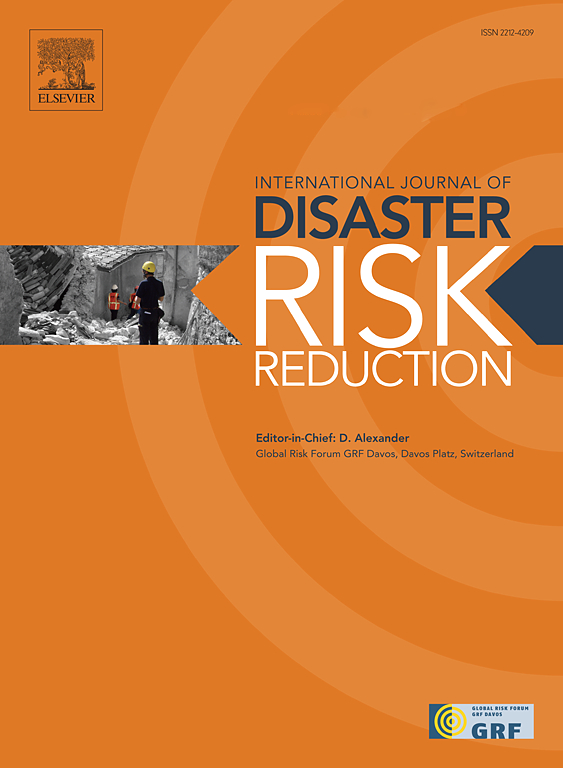公共政策增加风险的意外后果:巴西Revólver盆地的安全发展悖论
IF 4.5
1区 地球科学
Q1 GEOSCIENCES, MULTIDISCIPLINARY
International journal of disaster risk reduction
Pub Date : 2025-07-16
DOI:10.1016/j.ijdrr.2025.105697
引用次数: 0
摘要
不断升级的气候危机促使各国政府实施适应措施以加强安全。然而,这些努力可能无意中鼓励高风险地区的发展,这种现象被称为“安全发展悖论”(SDP)。虽然已经研究了与结构性措施有关的SDP,但对非结构性措施的影响仍然知之甚少。在这里,我们研究了公共政策和非故意减少灾害风险(DRR)措施如何促进Revólver流域的可持续发展,该地区受到复合水文灾害(山体滑坡、泥石流和山洪暴发)和2019冠状病毒病的影响。通过保护动机理论的视角,采用混合方法(包括151次社区成员访谈、10次利益相关者访谈、政策文件分析和空间分析),我们发现响应性措施主要是非保护性措施。三分之一的受访者表现出一种错误的安全感,这是由于他们对政府的信任和将建筑许可证视为安全指标的看法造成的。涉众指出,由于研究区域被认为是安全的,因此没有DRR行动。不充分的风险测绘、城市向高风险地区的扩张以及对河岸法规的放松促进了在危险地区的定居,强化了一种错误的安全感,加剧了SDP。因此,地方政府的政策影响了社会民主党,特别是在灾害不频繁的地区。我们的研究结果表明,非结构性政策,包括那些与DRR间接相关的政策,可能会无意中增加风险。因此,我们建议扩大SDP的概念,包括有意和无意的DRR措施和政策,导致意想不到的后果。本文章由计算机程序翻译,如有差异,请以英文原文为准。
Unintended consequences of public policies in increasing risk: the safe development paradox in the Revólver basin, Brazil
The escalating climate crisis prompts governments to implement adaptation measures to enhance safety. However, these efforts may unintentionally encourage development in high-risk areas, a phenomenon known as the ‘safe development paradox’ (SDP). While the SDP has been studied in relation to structural measures, the influence of non-structural measures remains poorly understood. Here, we examine how public policies and non-intentional disaster risk reduction (DRR) measures contribute to the SDP in the Revólver basin – a region in Brazil affected by a compound hydrological disaster (landslides, debris flow, and flash floods) and COVID-19. Using a mixed methods approach through the lenses of the protection motivation theory – including 151 interviews with community members, 10 stakeholder interviews, policy document analysis, and spatial analysis - we found that responsive measures were predominantly non-protective. A third of the interviewees exhibited a false sense of safety, fostered by their trust in the government and the perception of building permits as safety indicators. Stakeholders indicated that DRR actions were absent, as the study area was considered secure. Inadequate risk mapping, urban expansion into high-risk areas, and the relaxation of riparian regulations facilitated settlement in hazardous regions, reinforcing a false sense of safety and exacerbating the SDP. Therefore, local government policies influenced the SDP, particularly in regions where disasters are not frequent. Our findings suggest that non-structural policies, including those indirectly related to DRR, can unintentionally increase risk. Hence, we propose broadening the SDP concept to include both intentional and non-intentional DRR measures and policies inducing unintended consequences.
求助全文
通过发布文献求助,成功后即可免费获取论文全文。
去求助
来源期刊

International journal of disaster risk reduction
GEOSCIENCES, MULTIDISCIPLINARYMETEOROLOGY-METEOROLOGY & ATMOSPHERIC SCIENCES
CiteScore
8.70
自引率
18.00%
发文量
688
审稿时长
79 days
期刊介绍:
The International Journal of Disaster Risk Reduction (IJDRR) is the journal for researchers, policymakers and practitioners across diverse disciplines: earth sciences and their implications; environmental sciences; engineering; urban studies; geography; and the social sciences. IJDRR publishes fundamental and applied research, critical reviews, policy papers and case studies with a particular focus on multi-disciplinary research that aims to reduce the impact of natural, technological, social and intentional disasters. IJDRR stimulates exchange of ideas and knowledge transfer on disaster research, mitigation, adaptation, prevention and risk reduction at all geographical scales: local, national and international.
Key topics:-
-multifaceted disaster and cascading disasters
-the development of disaster risk reduction strategies and techniques
-discussion and development of effective warning and educational systems for risk management at all levels
-disasters associated with climate change
-vulnerability analysis and vulnerability trends
-emerging risks
-resilience against disasters.
The journal particularly encourages papers that approach risk from a multi-disciplinary perspective.
 求助内容:
求助内容: 应助结果提醒方式:
应助结果提醒方式:


